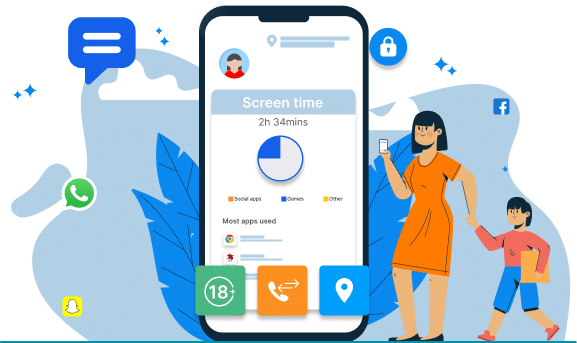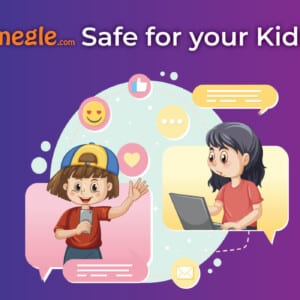
Ongoing development of artificial intelligence refers to integration of numerous innovations that have significantly gleaned various interfaces through child coloring pages. The advantages that can be derived from artificial intelligence are countless but so are the risks that parents need to know to protect their kids from when using the internet.
This article discusses the dangers of AI and gives safety tips for parents on how to protect their teens and keep them safe online.
Key Takeaways
Of course, parents need to protect their children and the first thing they have to learn is what AI is.
- Understand AI: Learn what AI is and how it impacts your child’s online experiences.
- Know the Risks: Be aware of the risks so you can protect your child.
- Encourage Open Communication: Talk freely with your children about their online activities.
- Monitor Activities: Keep an eye on what your child does online to reduce risks.
What is AI for Kids?
AI It is the branch of computer science, which focuses on making computer systems do what would normally require human intelligence to do. In general, AI is present in applications of kids’ products, including educational ones and games.
Though these technologies can play a role of a facilitator and improve the perspective of learning and engagement, parents should help kids understand the good side of AI and be aware of its side effects.
It’s entertaining for kids, but they must learn that not all things they find on the internet are friendly or truthful. That is why, parents, explaining the concept of AI in a simple manner to a child, can help the kid to get through this digital environment safer.
What Are the Dangers of AI to Children?
AI is everywhere, but it’s not all good for kids. It’s important to understand how AI can affect them and how to keep them safe.
Data Privacy Violations:
The law allows personal information to be gathered without consent hence misuse. Children, especially the young ones, may not be able to grasp the value of their data being protected.
Exposure to Inappropriate Content:
Algorithms may cause children to come across materials that are not suitable for their age. These can include violent rich/videos or other pictures that are lewd for the tender age of a child. If your child is using ChatGPT, make sure to guide them on how to use it safely and remind them to ask an adult if they’re unsure about anything.
AI Manipulation:
Children can be reached by the trickery or propaganda. For instance, they may come across what looks like a friendly chat bot that’s main goal is to prise out their identity.
Screen Time and Health Concerns:
When using child AI gadgets will complain of eye problems such as strain and is likely to lead to development of other diseases due to lack of physical activities. It can also affect sleep, making kids feel less rested. Parents can help by encouraging breaks and more active play.

Knowing these AI risks will go a long way in helping the parents who want to ensure their children do not fall victim to technology.
Signs of AI-Related Threats
Parents should watch for signs that their child might be facing dangers from AI. Catching these early can help keep them safe in a world full of technology.
Changes in Online Behavior:
An abrupt change in your child’s behaviour on social media is the perfect sign that they are being exposed to some bad content or people. Probably if they try to remove or hide any trace of their online safety then this should be an alarm.
Receiving Inappropriate Content:
Pay attention to possible input, which may contain unwanted messages, and links to potentially dangerous material. If your child spends a lot of time talking about things that do not concern him or her or things that are wrong, then it may need attention.
Mental or Emotional Distress:
It is thus important to note that fluctuations in mood and behaviour may be indicative of distress regarding the online processes. If your child appears distressed or upset after using a number of applications or sites, their feelings matter.
Unusual Requests for Personal Information:
If your child receives any requests for personal information from unknown sources, you should be cautious. These could include questions about their location, school, or any other details that require a response.
Parents can take action before a situation worsens when they are keen on these signs.
How to Protect Children from AI Risks
What most parents worry about, stakeholders bear the responsibility of protecting children against the risks that come with AI. Here are some effective strategies:
Teach Children About AI and Data Privacy:
It’s important to teach your kids about the value of privacy online and how to protect their personal information. Explain the types of details that are safe to share on social media, like general interests, and what should stay private, such as their address, school, or passwords. This helps them stay safe while using the AI.

Open Communication:
Encourage children to talk about what they do on the internet and the things they come across. Ask them to relate any cases that make them uncomfortable when using technology.
Use Kid-Friendly Apps:
It is safer to use applications specially made for children that will not contain adult-related loopholes. Parents can use some portals which provide specific age content that is strictly protected from any viruses and contains unhealthy content.
Set Clear Limits on Their Smart Tech Usage:
Set rules and some AI applications can help for how much time your child can spend on screens and what content is okay to use. Creating a family media plan helps manage device use and keep things balanced.
Encourage a Variety of Learning and Play:
Take a break from the Internet and start try some offline activities. Engage your child in activities such as sports, reading books or doing arts and crafts with clay that will not require the use of screens.
Stay Informed and Updated:
Stay informed about new IG tech and the risks it may bring, like privacy issues or harmful content that could affect your child. For example, you can regularly check resources on AI safety, stay updated on social media changes, and review new privacy settings to ensure your child stays safe online.
Monitor Online Activity:
Monitor your child’s social activities on the Internet and the stuff they do online on a regular basis. For example, using parental control app like TiSPY or Circle to monitor online activity can give parents peace of mind.
Create a Safe Digital Environment:
Parents should put some guard into their children to protect them while they are on the Internet. You should be able block the website which you think are not ok for your child to view them before Even them get to see them.
This way parents can minimise the danger that comes with AI and at the same time enable children to reap the benefits of the educational applications that come with technology.
Conclusion
As technology advances, parents must understand the risks of artificial intelligence to protect their children. By using effective strategies and fostering communication, they can help defend against potential dangers. Emphasizing online safety lessons will empower children to navigate technology safely and responsibly in the digital age.




